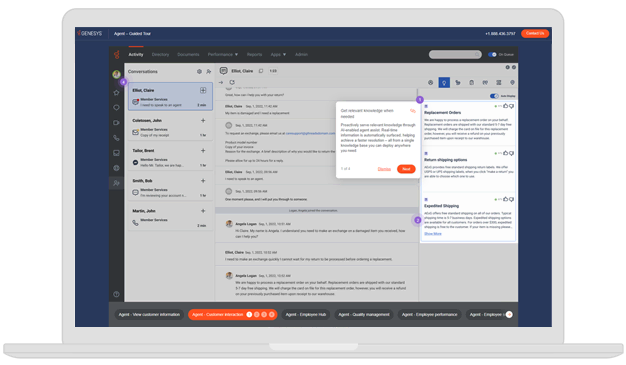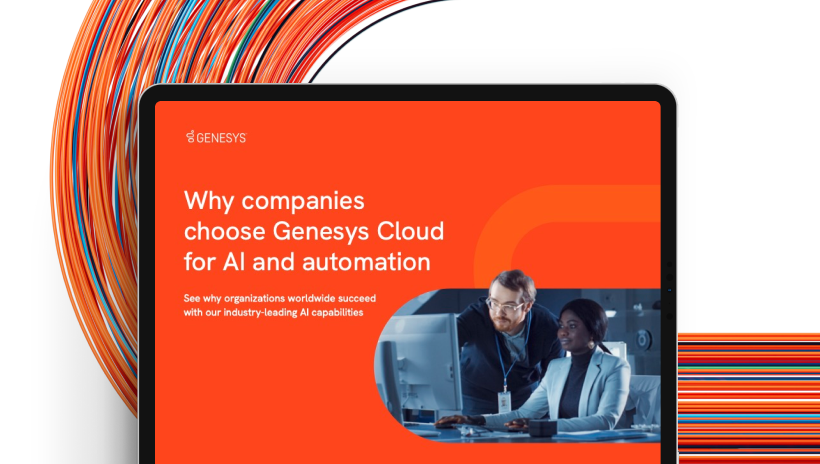Understanding agent-assist technology in digital CX
Delivering great customer service in the digital age requires more than well-trained agents and responsive systems. It demands tools that can keep pace with dynamic customer expectations — and support the employees tasked with meeting them.
Agent assist technologies, powered by artificial intelligence (AI) and sometimes called agent copilots, are emerging as essential partners in this effort. These tools provide in-the-moment guidance, automate repetitive tasks and elevate the agent experience, all while improving outcomes for customers.
As businesses increasingly turn to AI to scale efficiency and personalization, agent-assist tools have become a strategic investment. The right solution doesn’t just help agents work faster. It empowers them to focus on what human beings can still do better than machines: building meaningful relationships with customers that foster long-term loyalty.
What are agent-assist tools and how do they work?
Agent-assist tools are AI-powered applications that operate in the background of the customer experience (CX), providing live support to agents and supervisors alike. They follow conversations in real time — across digital and voice channels — surfacing relevant knowledge, suggesting next-best actions and automating post-call tasks such as summarization or tagging.
Unlike passive dashboards or post-interaction analytics, agent assist solutions are designed to intervene in the moment. They act as copilots, delivering timely nudges and insights while minimizing disruption to the flow of the conversation.
Key differences between traditional and AI-powered agent assist
Traditional agent tools often required agents to search through knowledge bases, toggle between screens or manually interpret customer data. These fragmented experiences slowed down responses and increased cognitive load. By contrast, modern AI-powered tools proactively anticipate what the agent might need next — drawing from contextual cues, customer data and historical interactions.
The result is that agents no longer spend time searching for answers; the answers arrive just when they’re needed.
Core features of modern solutions
Real-time information retrieval and suggested responses
One of the most visible benefits of agent assist is real-time content delivery. As customers describe their needs, the system fetches relevant knowledge articles, help guides or form links. In some cases, it may even suggest full responses or prompts the agent can tailor and send — speeding up resolution time without sacrificing empathy or accuracy.
Sentiment analysis and automated task management
Agent-assist tools also interpret the emotional tone of a conversation, alerting agents and supervisors when tension rises or when a customer seems confused. These insights can trigger automated workflows: Surfacing escalation options, recommending de-escalation scripts or scheduling a follow-up.
Simultaneously, the system can manage back-end tasks such as logging interaction details, generating wrap-up codes and tagging key topics. This reduces administrative overhead and ensures more consistent data capture across teams.
Integration with knowledge management and CRM systems
To be effective, agent-assist tools must connect seamlessly with the systems that house customer and business data. That includes knowledge bases, customer relationship management (CRM) platforms and case management tools. When integrated properly, agent assist can contextualize every interaction — showing not only the customer’s question but also their journey so far, previous touchpoints and likely next steps.
Continuous learning and improvement
The most advanced agent assist solutions are not static. They learn from every interaction — improving their recommendations over time, identifying new knowledge gaps and adapting to shifts in product or service offerings. With proper guardrails, this feedback loop allows the system to continuously improve, adapting to both how agents work and what customers expect.
Business benefits of implementing agent-assist tools
Enhancing efficiency and call resolution rates
When agents are supported in real time, they can resolve issues more quickly and confidently. Instead of placing customers on hold to search for answers or check procedures, they can stay focused on the conversation. This reduces average handling time (AHT) and improves first-contact resolution (FCR) — two key metrics for any contact center.
Improving customer satisfaction and agent performance
Customers benefit from faster, more informed responses. But they also notice something deeper: the experience feels smoother, more attentive and more tailored to their needs. For agents, the impact is equally significant. With copilots handling routine tasks and surfacing relevant information, agents can focus on building rapport and solving complex problems, which makes their work more fulfilling and less stressful.
Cost savings and operational scalability
Automating repetitive tasks reduces the need for manual oversight, freeing up time and resources across the organization. This translates into measurable cost savings and allows teams to scale operations without proportionally increasing headcount. It also helps new agents ramp up faster, reducing training costs and time to proficiency.
Competitive advantage in the digital age
In industries where the quality of the customer experience is a chief differentiator, the ability to respond quickly, empathetically and consistently across channels provides a powerful advantage. Agent-assist tools make this possible, not just by optimizing individual interactions but also by creating a foundation for continuously improving customer journeys.
Implementation considerations
Integration with existing technology stack
Successful deployment of agent-assist tools depends on how well they integrate with your current infrastructure. APIs, connectors and data synchronization must be carefully planned to guarantee real-time performance and reliability. Compatibility with knowledge and CRM systems is especially important to avoid duplicative effort or outdated information.
Training and onboarding for agents
Even the best tools need thoughtful rollout. Agents must be trained not only in how to use the new interface, but also how to collaborate with it. That means knowing when to trust a suggested response, how to escalate issues the AI can’t resolve and how to give feedback that improves the system over time.
Ensuring compliance and data security
Because agent-assist tools process live interactions and personal information, privacy and compliance are critical. Vendors must support data encryption, access controls and adherence to regional regulations such as GDPR or CCPA. Organizations must also ensure that AI-generated suggestions align with brand standards and legal policies.
Measuring ROI and success metrics
To gauge the effectiveness of agent-assist, teams should track a mix of operational and experiential metrics. These may include average handle time, first-contact resolution, agent satisfaction (ESAT), customer satisfaction (CSAT) and training time for new hires. Over time, the system should contribute to better business outcomes, from cost reduction to higher loyalty scores.
Future of agent assist and AI in customer experience
The role of generative AI in real-time guidance
Generative AI is now enabling a new generation of agent-assist capabilities. Beyond summarizing interactions or suggesting next-best actions, AI copilots can craft personalized responses, translate conversations across languages and synthesize complex data into a clear narrative. Rather than override human judgment, these functions enhance it — guiding agents toward faster, more confident decisions.
Evolving customer expectations in digital interactions
As more businesses adopt agentic AI-enhanced service models, customers are coming to expect faster, smarter and more human-feeling interactions. Agent-assist tools play a key role in meeting those expectations — ensuring that even as digital volumes rise, the quality of engagement remains high.
Predictions for the next 5 years
In the near future, agent assist will extend beyond traditional contact centers into sales, field service and even back-office operations. As AI becomes more embedded across workflows, the line between support and strategy will blur, and agent assist will evolve from a helpful tool into a standard way of working across the enterprise.
Equip your agents to meet the moment
Agent-assist tools are no longer a luxury; they’re a necessity for modern digital CX. By supporting human agents with real-time insights, intelligent automation and contextual awareness, these tools enhance every conversation, reduce operational drag and strengthen both customer and employee experiences. As the digital landscape continues to evolve, organizations that empower their teams with AI-powered assistance will be better equipped to meet the moment — and the customer — with confidence.
Frequently Asked Questions
What security or privacy concerns should businesses consider with agent-assist tools?
Because agent assist solutions process live customer data, strong governance and compliance measures are essential. Businesses should ensure that vendors support encryption in transit and at rest, adhere to regulations such as GDPR and CCPA, and offer granular access controls. It’s also important to review how AI models are trained and what data they retain — transparency and traceability are key to maintaining trust and regulatory compliance.
What should I look for when choosing an agent assist solution for my company?
The best agent-assist tools combine real-time intelligence with usability. Look for solutions that integrate easily with your existing systems, provide configurable workflows, and offer explainable AI recommendations that align with your brand standards. Scalability is also critical; your platform should grow with your business while maintaining speed, reliability and compliance. Finally, consider whether the vendor provides ongoing updates and AI model improvements to ensure long-term value.
How can agent assist improve both digital and voice-based customer interactions?
Agent-assist tools operate across channels, offering the same level of guidance and automation in voice calls as they do in chat, email or social interactions. During live calls, AI can analyze tone and intent to provide suggested responses or escalation cues. In digital channels, it can automate data entry, summarize conversations and even translate messages in real time. It can also summarize voice conversations. This omnichannel consistency helps agents deliver a seamless experience regardless of how customers choose to connect.
Do agent-assist tools require extensive training for agents to use effectively?
Most agent assist platforms are designed for simplicity and minimal disruption to existing workflows. Agents typically interact with copilots through an intuitive interface that provides contextual prompts, summaries, or next-best actions as they work. While short onboarding sessions are needed to build confidence, the tools are intended to reduce cognitive load — not add to it. Over time, agents often find the system becomes a natural extension of how they work.







